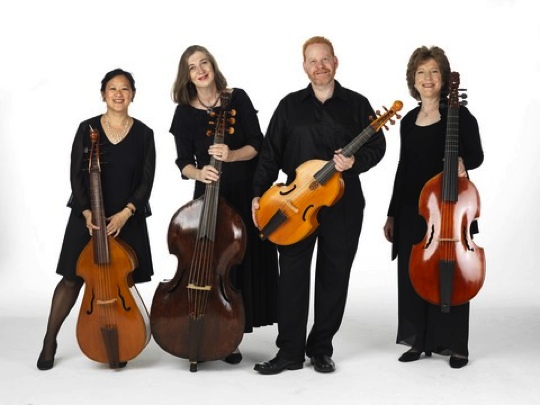Parthenia Viol Consort presents “For Ye Violls”
Concert at Church of St. Luke in the Field gave luminous and lovely insight into the work of the English baroque composer with added treble viol and organ.

Parthenia Viol Consort presents “For Ye Violls”: “The Consort Setts for 5 viols” by William Lawes (Photo credit: William Wegman)
On Sunday, October 12, 2014 in the formal, solid and spare space of St. Luke in the Fields, the viol quartet Parthenia (Beverly Au, Lawrence Lipnik, Rosamund Morley and Lisa Terry), treble viol player Joanna Blendulf and organist David Shuler presented a rich and marvelous afternoon of the works of William Lawes (1602-1645). The six musicians played beautifully: each was attuned to the others, to the constant, shifting richness of their shared sound and to the astonishing compositional range of William Lawes.
Mark Rodgers’ excellent program notes provided a sound portrait of Lawes’ tragically short life and of some of the most innovative and striking features of his music. But program notes alone could not prepare the listener for the remarkable experience of a whole concert of Lawes’ works transmitted from score to audience by these musicians’ luminous performance.
Viols are both delicate and resilient instruments. They require near constant tuning because they are so sensitive to the players’ touch and bows. Within a relatively small range of volume from piano to forte, they also can convey sounds of tremendous complexity and subtlety. The small portable organ played by Shuler was a fine match for the viols. Throughout this performance, Parthenia and their colleagues conveyed a genuine sense of delight about their instruments: occasionally after a particularly elegant or gorgeous or entirely unexpected musical moment, the musicians would exchange quite happy, near goofy smiles.
The program consisted of five “consort setts:” there were three before the intermission and two after. Each sett opened with a “fantasy”and closed with an “aire.” The second, third and fifth setts featured “pavanes” as their centerpieces. Over the course of the five setts, the music became incrementally more stunning and audacious.
Lawes was a man of his times: he was a courtier in the court of King Charles, a time and place of frightening, confused and volatile transition, in which the politically vulnerable monarch surrounded himself with magnificent contemporary art and artists. Lawes was one of the very best of the court musicians as well as a personal friend of the king.
English baroque court music is steeped in contradictions. It is both intimate and public; it is conventional and playful; it is topical and occasional on the one hand and non-specifically accessible on the other. Lawes inherited these basic contradictions together with the demanding formal features of traditional musical genres. Within these constraints, he was so daringly inventive that artistic freedom is ultimately more his signature than genre or time period.
In Lawes’ setts, instruments engage in simultaneous duets and threesomes; melodies overheard from one musical conversation are incorporated, transposed and transformed in other conversations. Sometimes chords and tunes hover between harmony and dissonance while rhythms are familiar; sometimes melodies are mellifluous while rhythms are syncopated and divergent, placed in opposition to each other. Luscious cascades of melodic sound exist simultaneously with sharp-edged, intricate counterpoint experiments; musical sound ranges from crystalline delicacy to sensuous symphonic sweep.
Lawes’ aires move significantly beyond their pastoral origins. Some have the feel of a narrative or a character analysis. Occasionally, the basic sweetness of the genre becomes sophisticated, witty and flirtatious: the sounds of the country are made urbane.
Lawes’ music transcends the original purposes of the various genres he so easily inhabits to become an invitation to an intimate and interior consideration of human experiences. Lawes’ pavanes are rich, ruminative explorations of psyche and heart. They are introspective without self-indulgence. They are meditative not in the sense of mental emptying but of profound immersion in the movements of remembering, feeling, imagining and anticipating.
Over the course of the performance, Lawes’ music in Parthenia’s and their colleagues’ hands became an entrance into intense concentration, at once cerebral and sensual. Listening became something like looking at Jacobean embroidery, tracing the paths of individual threads, alone and in groups, over and across and under and back again towards all other threads, and simultaneously seeing plant tendrils or birds’ wings. Listening became like watching a corps of Balanchine ballerinas swirling around the stage. One can see either individual dancers or fluid lines of many dancers’ movements; in rare moments of free-float awareness, one can see both at the same time.
This concert was a gorgeous revelation of Lawes’ music of risks and paradoxes, flashes of the unexpected, the familiar skewed to seem strange and the strange made comfortable … all within the specialized and rarefied vocabulary of Stuart England court music. Parthenia’s and their colleagues’ gorgeous musicianship made Lawes’ technically difficult music seem clean and effortless. More important, however, is these musicians’ organic oneness with what they play: because they have cultivated modern and contemporary music either adapted or newly crafted for their old instruments, Parthenia experiences and conveys newness and risk in whatever era they find them. Last Sunday, the audience heard Lawes’ modernity and his daring with both the musicians’ evocation of the Stuart court’s sensibility and our own twenty-first century assumptions and expectations.
The large audience – an enthusiastic, non-geriatric, mixed age, mixed race group with at least two children who looked about eight – couldn’t have been happier. The applause and heartily shouted Bravos! were raucous; everyone was beaming.
What a wonderful beginning to Parthenia’s 2014-2015 season! This was the first event of “The Art of Persuasion” concert series.
Parthenia Viol Consort presents “For Ye Violls”:“The Consort Setts for 5 Viols” by William Lawes (October 12, 2014)
Church of St. Luke in the Fields, 487 Hudson Street, in Manhattan
For more information, call 212-924-0562 or visit http://www.stlukeinthefields.org



Leave a comment